
The San Juan Basin is a geologic structural basin located near the Four Corners region of the Southwestern United States. The basin covers 7,500 square miles and resides in northwestern New Mexico, southwestern Colorado, and parts of Utah and Arizona. Specifically, the basin occupies space in the San Juan, Rio Arriba, Sandoval, and McKinley counties in New Mexico, and La Plata and Archuleta counties in Colorado. The basin extends roughly 100 miles (160 km) N-S and 90 miles (140 km) E-W.
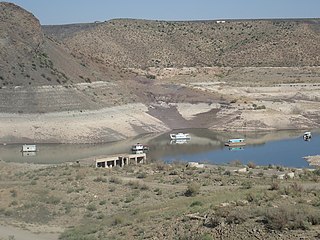
The McRae Formation is a geological formation exposed in southern New Mexico whose strata date back to the Late Cretaceous. Dinosaur remains are among the fossils that have been recovered from the formation.
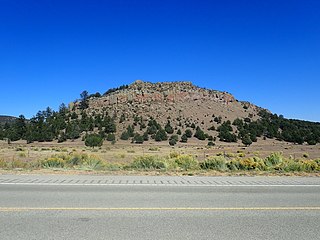
The Mogollon-Datil volcanic field is a large silicic volcanic field in western New Mexico. It is a part of an extensive Eocene to Oligocene volcanic event which includes the San Juan volcanic field in southwestern Colorado, the Trans-Pecos volcanic field in west Texas and north central Mexico, the Boot Heel volcanic field in the bootheel of southwestern New Mexico and adjacent areas of Arizona and Mexico; and the vast volcanic field of the Sierra Madre Occidental of western Mexico. The Mogollon-Datil volcanic field was formed in "four discrete pulses representing synchronized activity of two separate cauldron complexes".
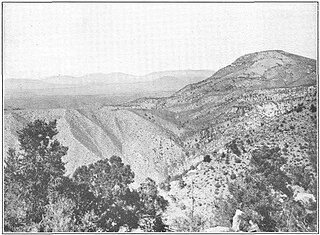
The Gila Group is a group of geologic formations found along the upper tributaries of the Gila River in Arizona and New Mexico. Radiometric dating of lava flows within the group yields an age of Miocene to Quaternary.

The Popotosa Formation is a geologic formation in New Mexico. It preserves fossils dating back to the Neogene period. These include the Socorro flora, notable for its fine preservation of plant reproductive structures.
The Cub Mountain Formation is a geologic formation in southern New Mexico. It preserves fossils dating back to the Eocene epoch. The formation also records the progressive unroofing of nearby mountainous uplifts during the Laramide orogeny.

The Galisteo Formation is a geologic formation in New Mexico. It contains fossils characteristic of the Bartonian stage of the Eocene epoch, Duchesnean in the NALMA classification.
The Hart Mine Formation is a geologic formation controversially defined from exposures in south-central New Mexico. It preserves fossils dating back to the Eocene epoch.

The Rubio Peak Formation is a geologic formation in southwestern New Mexico. It is thought to have been deposited in the Eocene Epoch.

The Santa Fe Group is a group of geologic formations in New Mexico and Colorado. It contains fossils characteristic of the Oligocene through Pleistocene epochs. The group consists of basin-filling sedimentary and volcanic rocks of the Rio Grande rift, and contains important regional aquifers.

The Tanos Formation is a geologic formation in central New Mexico. It is estimated to be about 25 million years in age, corresponding to the Oligocene epoch.
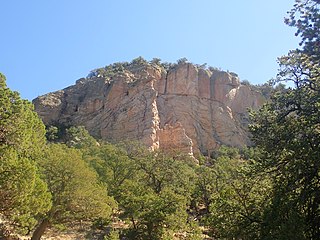
The Spears Group is a group of geologic formations exposed in and around the northeast Mogollon-Datil volcanic field of southwestern New Mexico. It has a radiometric age of 33 to 39 million years, corresponding to the Eocene to Oligocene epochs.
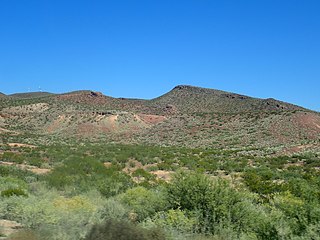
The Hayner Ranch Formation is a geologic formation found near the San Diego Mountains of New Mexico. It is estimated to have been deposited during the Miocene epoch.
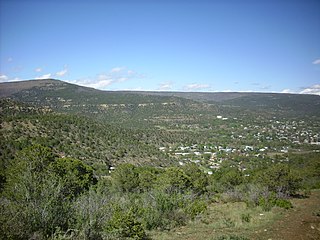
The Trinidad Sandstone is a geologic formation in northeastern New Mexico and southeastern Colorado. It was formed during the Campanian Age of the Cretaceous Period and contains fossils.
The Love Ranch Formation is a geologic formation in southern New Mexico. It was likely deposited during the late Paleocene and early Eocene epochs.
The Bell Top Formation is a geologic formation in southern New Mexico. Radiometric dating of surrounding tuffs indicate that it was deposited in the Oligocene epoch.
The Cowboy Spring Formation is a geologic formation in southwestern New Mexico and southeastern Arizona. It preserves fossils dating back to the late Cretaceous period.
The Sanders Canyon Formation is a geologic formation exposed north and west of the Sierra Blanca of southern New Mexico. It preserves fossils dating back to the Eocene epoch.
The Bearwallow Mountain Andesite or Bearwallow Mountain Formation is a geologic formation exposed in and around the Mogollon Mountains of southwest New Mexico. It has a radiometric age of 27 to 23 million years, corresponding to the late Oligocene to early Miocene epochs.
The Timberlake Formation is a geologic formation exposed in the Animas Mountains of southwestern New Mexico. Its age is estimated to be late Paleocene to Eocene.













